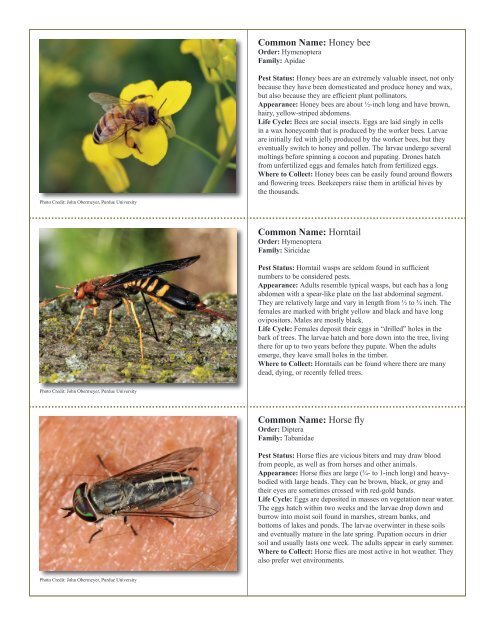to download pdf - Purdue Extension Entomology - Purdue University
to download pdf - Purdue Extension Entomology - Purdue University
to download pdf - Purdue Extension Entomology - Purdue University
Create successful ePaper yourself
Turn your PDF publications into a flip-book with our unique Google optimized e-Paper software.
Common Name: Honey bee<br />
Order: Hymenoptera<br />
Family: Apidae<br />
Pho<strong>to</strong> Credit: John Obermeyer, <strong>Purdue</strong> <strong>University</strong><br />
Pest Status: Honey bees are an extremely valuable insect, not only<br />
because they have been domesticated and produce honey and wax,<br />
but also because they are efficient plant pollina<strong>to</strong>rs.<br />
Appearance: Honey bees are about ½-inch long and have brown,<br />
hairy, yellow-striped abdomens.<br />
Life Cycle: Bees are social insects. Eggs are laid singly in cells<br />
in a wax honeycomb that is produced by the worker bees. Larvae<br />
are initially fed with jelly produced by the worker bees, but they<br />
eventually switch <strong>to</strong> honey and pollen. The larvae undergo several<br />
moltings before spinning a cocoon and pupating. Drones hatch<br />
from unfertilized eggs and females hatch from fertilized eggs.<br />
Where <strong>to</strong> Collect: Honey bees can be easily found around flowers<br />
and flowering trees. Beekeepers raise them in artificial hives by<br />
the thousands.<br />
Common Name: Horntail<br />
Order: Hymenoptera<br />
Family: Siricidae<br />
Pest Status: Horntail wasps are seldom found in sufficient<br />
numbers <strong>to</strong> be considered pests.<br />
Appearance: Adults resemble typical wasps, but each has a long<br />
abdomen with a spear-like plate on the last abdominal segment.<br />
They are relatively large and vary in length from ½ <strong>to</strong> ¾ inch. The<br />
females are marked with bright yellow and black and have long<br />
oviposi<strong>to</strong>rs. Males are mostly black.<br />
Life Cycle: Females deposit their eggs in “drilled” holes in the<br />
bark of trees. The larvae hatch and bore down in<strong>to</strong> the tree, living<br />
there for up <strong>to</strong> two years before they pupate. When the adults<br />
emerge, they leave small holes in the timber.<br />
Where <strong>to</strong> Collect: Horntails can be found where there are many<br />
dead, dying, or recently felled trees.<br />
Pho<strong>to</strong> Credit: John Obermeyer, <strong>Purdue</strong> <strong>University</strong><br />
Common Name: Horse fly<br />
Order: Diptera<br />
Family: Tabanidae<br />
Pest Status: Horse flies are vicious biters and may draw blood<br />
from people, as well as from horses and other animals.<br />
Appearance: Horse flies are large (¾- <strong>to</strong> 1-inch long) and heavybodied<br />
with large heads. They can be brown, black, or gray and<br />
their eyes are sometimes crossed with red-gold bands.<br />
Life Cycle: Eggs are deposited in masses on vegetation near water.<br />
The eggs hatch within two weeks and the larvae drop down and<br />
burrow in<strong>to</strong> moist soil found in marshes, stream banks, and<br />
bot<strong>to</strong>ms of lakes and ponds. The larvae overwinter in these soils<br />
and eventually mature in the late spring. Pupation occurs in drier<br />
soil and usually lasts one week. The adults appear in early summer.<br />
Where <strong>to</strong> Collect: Horse flies are most active in hot weather. They<br />
also prefer wet environments.<br />
Pho<strong>to</strong> Credit: John Obermeyer, <strong>Purdue</strong> <strong>University</strong>
















